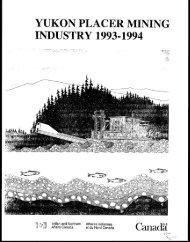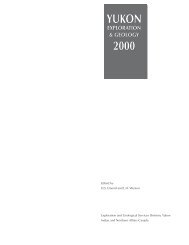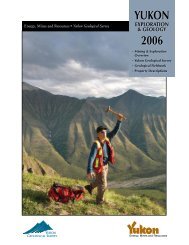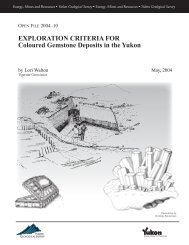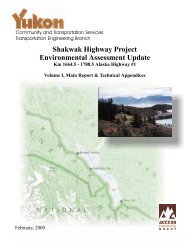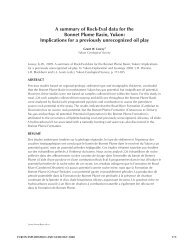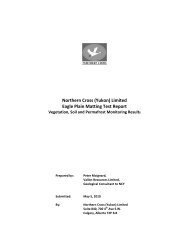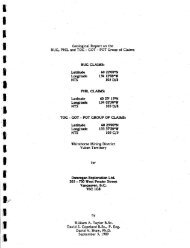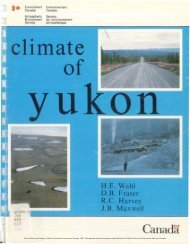WhiteCAP_Plan_01SEPT..
WhiteCAP_Plan_01SEPT..
WhiteCAP_Plan_01SEPT..
You also want an ePaper? Increase the reach of your titles
YUMPU automatically turns print PDFs into web optimized ePapers that Google loves.
NCE <strong>WhiteCAP</strong> Environmental History<br />
1.0 Introduction<br />
The term climate change refers to a significant change in the variability or average state<br />
of the climate (IPCC). Adaptive capacity as it relates to climate change is the ability or<br />
potential ability of a community to adjust to climate change by addressing and planning<br />
for changes, taking advantage of related opportunities, or coping with the consequences<br />
of change 1 (modified from IPCC 2007). Current model predictions by the<br />
Intergovernmental Panel on Climate Change (IPCC), report the greatest climate<br />
warming in the eastern arctic. Yet, certain regions of the North West are also predicted<br />
to continue warming at a faster than average rate due to characteristic mountainous<br />
terrain and subsequent microclimates. In particular, the Yukon has warmed at an<br />
unprecedented rate (IPCC 2007). Of particular interest is the ability of the capital city of<br />
Whitehorse to respond adaptively to reoccurring environmental stresses that are likely to<br />
increase in severity and frequency due to a warming climate. We define an<br />
environmental stress as an extreme, generally short-lived, natural event that tends to<br />
impact the immediate landscape. The findings of this report will assist with the evaluation<br />
of adaptive capacity during the development of the Whitehorse Community Climate<br />
Change Adaptation <strong>Plan</strong>. For this reason, the environmental stresses highlighted in this<br />
report are those likely to be affected by climate change. We provide an overview of how<br />
environmental stresses affected the community from 1930 to 2009, by: 1) identifying the<br />
primary stresses affecting Whitehorse, 2) providing historical examples of related events<br />
of how residents and the city responded, and 3) gauging the community’s adaptive<br />
capacity to respond to potential impacts of climate change related events based on<br />
historical responses.<br />
Geographically, Whitehorse is a relatively remote community located in the southern<br />
region of the Yukon Territory, at 60°43’N and 135°4’W. Whitehorse is situated in the<br />
Upper Yukon Basin, a region characterised by deep river valleys and an elevation grade<br />
of 600-1200m. Climate is continental with a highly variable daily and seasonal<br />
temperature regime. On average, the region receives 200-300mm of precipitation<br />
annually 2 . The regional climate is influenced by teleconnections between the Pacific<br />
Decadal Oscillation, the El Nino Southern Oscillation, and the Arctic Oscillation 3 . The<br />
community is considered relatively urban by Northern standards. As of 2006 4 , the<br />
population of Whitehorse was 22,114-23,991 residents – approximately 75% the<br />
population of Yukon. Because of its central location along the Alaska Highway and<br />
relatively high population density, Whitehorse functions as an economic and service hub<br />
for the territory.<br />
1 IPCC: Intergovernmental Panel on Climate Change (http://www.ipcc.ch/)<br />
2<br />
Whal, H.E., Fraser, D.B., Harvey, R.C., and Maxwell, J.B. 1987. Climate of Yukon. Environment<br />
Canada, Government of Canada , Ottawa, Canada .<br />
3<br />
Werner, T. and Murdock, T. 2008. Changes in Past-Hydro-climatology and Projected Future<br />
Change for the City of Whitehorse: Summary Report.Pacific Climate Impacts Consortium,<br />
Victoria, Canada.<br />
4<br />
Yukon Bureau of Statistics. 2007. Population and Dwelling Counts; Census 2006 Information<br />
Sheet #C06-01. Yukon Government, Whitehorse Yukon. [Online 10 November 2009]<br />
http://www.eco.gov.yk.ca/stats/pdf/popdwell.pdf Ric Janowicz 2002<br />
D.1



